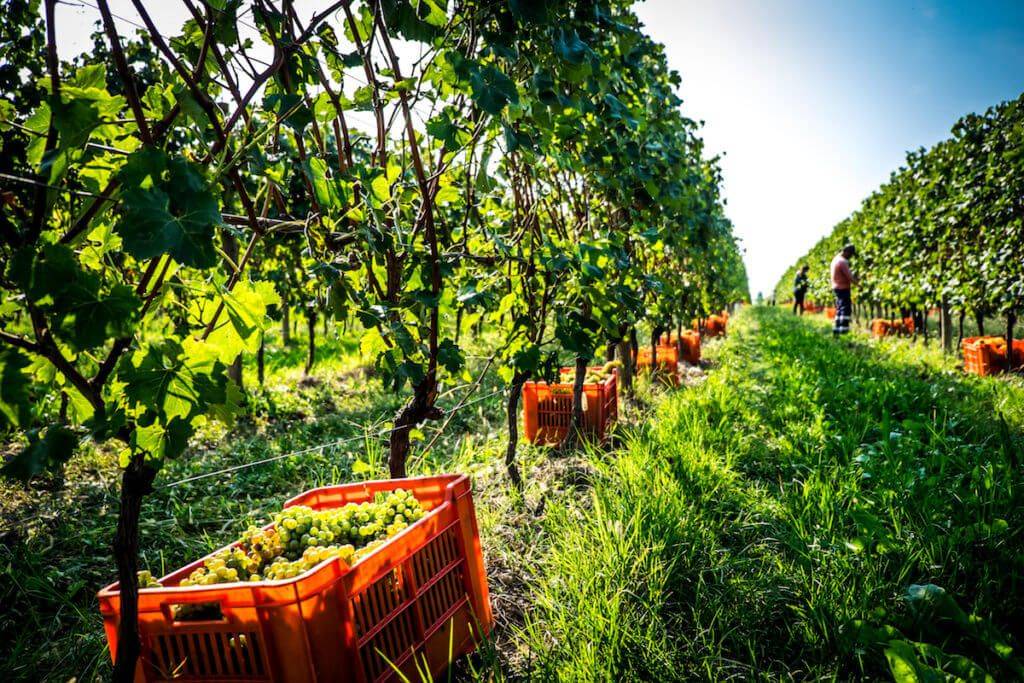by Laura Donadoni, LA Com Wine Agency
You may have heard about Lugana as a delicate, yet mineral wine from Northern Italy, but you don’t realize what Lugana really is, until you get there. Located in the strip of land on the on the southern coast of Lake Garda, between the Italian provinces of Brescia (Lombardia) and Verona (Veneto), it’s a place full of history, where grapes were cultivated back during the times of the Roman Empire. Spectacular lake views, ancient castles, and a vocation for touristic hospitality make Lugana a must-see destination for wine lovers.
In 1967, Lugana became the first wine of Lombardia to be registered as a DOC. Lugana is a relatively small wine region with 1,800 ha of vineyards, planted on the morainic hills around the southern coast of Lake Garda, with dense soil rich in clay and gravel. The influence of Lake Garda provides a mild climate, with little difference between daytime and nighttime temperatures. Made from the ancient, indigenous grape varietal Turbiana, Lugana has a very complex history.
According to wine reference guide, Wine Grapes by Jancis Robinson, Julia Harding and Jose Vouillamoz, there are approximately 25 synonyms for Lugana DOC found throughout northern and central Italy, most of which are not made with the same grape. Lugana was originally thought to be a variation of the Trebbiano variety but, through extensive DNA testing, has been discovered to be identical to Verdicchio Bianco and Trebbiano di Soave. In addition to the Turbiana grape, Lugana DOC allows use of other white non-aromatic grape varieties up to 10 percent.
Besides its unique indigenous grape, Lugana’s unusual growing conditions also play a crucial role in its winning formula. For the most part, Lugana is grown in low-lying plains in dense clay soil that covers a bed of mineral rich glacial moraine. According to producers, this compact soil forces the vines to produce fewer berries and leads to concentrated flavors, rich texture and full body. Besides the thick clay that naturally restrains the grape’s vigor and forces roots deep down to the nutrients below the surface, the Garda lake’s almost Mediterranean microclimate allows ideal ripening for Turbiana, a variety that matures unusually late.

Lugana is produced in five styles: standard Lugana, which requires one year of aging; Lugana superiore, which requires a lower yield per hectare and specific grape selection; Lugana Riserva, which requires a minimum of two years aging, six of which must be in the bottle; a spumante style produced in both the Charmat and Champenois methods; and a Lugana Late Harvest (also Vendemmia Tardiva) made with grapes that have been left on the vine to overripe and dry, resulting in grapes with a high concentration of flavors and sugars.
Generally speaking, Lugana wines have a very intense bouquet, with colors ranging from bright straw yellow to a slightly greenish shade. After a few years of aging, it acquires beautiful golden highlights. Due to the structure and the high acidity of Turbiana, combined with the minerality of the terroir of lower Garda, Lugana is one of the few white wines that can age beautifully. A good quality Lugana wine can easily be stored for 6-10 years or longer and it develops ethereal flavours like flint, rubber, graphite or petrol, like some Alsace Rieslings do with age.
In the last few years, Lugana gained a good reputation on the international wine scene. Consumer demand has increased, and sales have doubled in the last six years, generating intense investments in cutting edge technology and new plantings by already established producers in the denomination. In 2007, there were just 790 ha of vines dedicated to Lugana. That figure rose to over 1,000 ha in 2011 and over 1,800 ha in 2018, yielding more than 18 million bottles, 52% of which are exported globally.
The ageing potential and the complexity of these white wines of Northern Italy will surely conquer more and more palates around the world.
About Laura Donadoni: Laura Donadoni is an Italian wine journalist and influencer, based in San Diego, where she founded 5 years ago “The Italian Wine Girl” blog and La Com Wine Agency, a strategic P.R. and Communications firm focused on the wine industry. She is columnist for SommJournal and Tasting Panel magazine, a certified Sommelier with merit with the North American Sommelier Association and the World Sommelier Association, a Wset advanced sommelier; she is one of the few Vinitaly International Italian Wine Ambassadors in the world and a certified Wine Educator; she is an Italian and Spanish Wine Specialist; an official wine judge for the San Francisco Chronicle Wine Competition and many others international wine competitions, a member of the International Circle of Wine Writers and of the Los Angeles Wine Writers Association and the Director of the Wine Education Program at the Pacific National Food and Beverage Museum in L.A.







